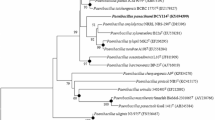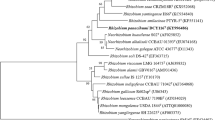Abstract
A novel actinobacterial strain, SB3-54T was isolated from rhizosphere soil of Cynanchum wilfodill, Jaecheon, Chungcheongbuk-do, Republic of Korea. Cells of strain SB3-54T were Gram-stain-positive, aerobic, rod-shaped, and flagellated which formed pale yellow colonies on Reasoner’s 2A (R2A) agar. Growth occurred at 15–30 °C (optimum 25 °C), pH 5–8 (optimum pH 7), and 0–2.5% NaCl (optimum 0%). Phylogenetic and phylogenomic analyses showed that strain SB3-54T formed a separate lineage in the genus Jatrophihabitans with Jatrophihabitans telluris N237T. Strain SB3-54T was positive for catalase activity. Genomic analysis showed that SB3-54T has plant-beneficial function contributing (referred to as PBFC) genes such as root colonization and plant protection from oxidative stress. Furthermore, genome of SB3-54T contained gene clusters related to cytokinin biosynthesis, auxin response, tryptophan biosynthesis, siderophore biosynthesis and bacterial toxin-antitoxin systems. Strain SB3-54T contained iso-C16:0 as the major fatty acid and MK-9(H4) and MK-9(H6) as the predominant quinones. The organism had meso-diaminopimelic acid as the diagnostic diamino acid in the peptidoglycan. The major polar lipids were diphosphatidylglycerol, phosphatidylinositol polymannosides, two unidentified aminoglycophospholipids and three unidentified phospholipids. Based on phylogenetic, physiological and chemotaxonomic characteristics, strain SB3-54T represents a novel species of the genus Jatrophihabitans. The type strain is SB3-54T (= KCTC 49134T = NBRC 114108T).


Similar content being viewed by others
Abbreviations
- GAP:
-
Good Agricultural Practice
- R2A:
-
Reasoner’s 2A
- TSA:
-
Tryptic soy agar
- NA:
-
Nutrient agar
- ANI:
-
Average nucleotide identity
- dDDH:
-
Digital DNA-DNA hybridization
- UBCG:
-
Up-to-date Bacterial Core Genes
References
Berendsen RL, Pieterse CM, Bakker PA (2012) The rhizosphere microbiome and plant health. Trends Plant Sci 17:478–486. https://doi.org/10.1016/j.tplants.2012.04.001
Blin K, Shaw S, Kloosterman AM, Charlop-Powers Z, Van Wezel GP, Medema MH, Weber T (2021) antiSMASH 6.0: improving cluster detection and comparison capabilities. Nucleic Acids Res 49(W1):W29–W35. https://doi.org/10.1093/nar/gkab335
Cherif-Silini H, Thissera B, Bouket AC, Saadaoui N, Silini A, Eshelli M, Alenezi FN, Vallat A, Luptakova L, Yahiaoui B (2019) Durum wheat stress tolerance induced by endophyte Pantoea agglomerans with genes contributing to plant functions and secondary metabolite arsenal. Int J Mol Sci 20:3989. https://doi.org/10.3390/ijms20163989
Chun J, Oren A, Ventosa A, Christensen H, Arahal DR, da Costa MS, Rooney AP, Yi H, Xu XW, De Meyer S, Trujillo ME (2018) Proposed minimal standards for the use of genome data for the taxonomy of prokaryotes. Int J Syst Evol Microbiol 68:461–466. https://doi.org/10.1099/ijsem.0.002516
Felsenstein J (1981) Evolutionary trees from DNA sequences: a maximum likelihood approach. J Mol Evol 17:368–376. https://doi.org/10.1007/BF01734359
Felsenstein J (1985) Confidence limits on phylogenies: an approach using the bootstrap. Evolution 39:783–791. https://doi.org/10.1111/j.1558-5646.1985.tb00420.x
Fitch WM (1971) Toward defining the course of evolution: minimum change for a specific tree topology. Syst Biol 20:406–416. https://doi.org/10.2307/2412116
Gong Z-L, Ai M-J, Sun H-M, Liu H-Y, Yu L-Y, Zhang Y-Q (2016) Jatrophihabitans huperziae sp. nov., an endophytic actinobacterium isolated from surface-sterilized tissue of the medicinal plant Huperzia serrata (Thunb.). Int J Syst Evol Microbiol 66:3972–3977. https://doi.org/10.1099/ijsem.0.001296
Hall TA (1999) BioEdit: a user-friendly biological sequence alignment editor and analysis program for Windows 95/98/NT. Nucleic acids symposium series. [London]: Information Retrieval Ltd., c1979-c2000., 95–98
Huerta-Cepas J, Szklarczyk D, Heller D, Hernãndez-Plaza A, Forslund SK, Cook H, Mende DR, Letunic I, Rattei T, Jensen LJ (2019) eggNOG 5.0: a hierarchical, functionally and phylogenetically annotated orthology resource based on 5090 organisms and 2502 viruses. Nucleic Acids Res 47:D309–D314. https://doi.org/10.1093/nar/gky1085
Jin L, Lee H-G, Ko S-R, Ahn C-Y, Oh H-M (2015) Jatrophihabitans fulvus sp. nov., an actinobacterium isolated from grass soil. Int J Syst Evol Microbiol 65:3476–3480. https://doi.org/10.1099/ijsem.0.000443
Kanehisa M, Sato Y, Kawashima M, Furumichi M, Tanabe M (2016) KEGG as a reference resource for gene and protein annotation. Nucleic Acids Res 44:D457–D462. https://doi.org/10.1093/nar/gkv1070
Kim S-J, Moon J-Y, Lim J-M, Hamada M, Ahn J-H, Weon H-Y, Suzuki K-I, Kwon S-W (2015) Jatrophihabitans soli sp. nov., isolated from soil. Int J Syst Evol Microbiol 65:1759–1763. https://doi.org/10.1099/ijs.0.000173
Kim J, Na S-I, Kim D, Chun J (2021) UBCG2: Up-to-date bacterial core genes and pipeline for phylogenomic analysis. J Microbiol 59:609–615. https://doi.org/10.1007/s12275-021-1231-4
Komagata K, Suzuki K-I (1987) Lipid and cell-wall analysis in bacterial systematics. Methods Microbiol 19:161–207. https://doi.org/10.1016/S0580-9517(08)70410-0
Lanyi B (1988) Classical and rapid identification methods for medically important bacteria. Methods in microbiology. Elsevier, New York. https://doi.org/10.1016/S0580-9517(08)70407-0
Lee I, Kim YO, Park S-C, Chun J (2016) OrthoANI: an improved algorithm and software for calculating average nucleotide identity. Int J Syst Evol Microbiol 66:1100–1103. https://doi.org/10.1099/ijsem.0.000760
Lee H, Kim MH, Choi YY, Hong J, Yang WM (2018a) Effects of Cynanchum wilfordii on osteoporosis with inhibition of bone resorption and induction of bone formation. Mol Med Rep 17:3758–3762. https://doi.org/10.3892/mmr.2017.8309
Lee KC, Suh MK, Eom MK, Kim KK, Kim J-S, Kim D-S, Ko S-H, Shin YK, Lee J-S (2018b) Jatrophihabitans telluris sp. nov., isolated from sediment soil of lava forest wetlands and the emended description of the genus Jatrophihabitans. Int J Syst Evol Microbiol 68:1107–1111. https://doi.org/10.1099/ijsem.0.002639
Madhaiyan M, Hu CJ, Kim S-J, Weon H-Y, Kwon S-W, Ji L (2013) Jatrophihabitans endophyticus gen. nov., sp. nov., an endophytic actinobacterium isolated from a surface-sterilized stem of Jatropha curcas L. Int J Syst Evol Microbiol 63:1241–1248. https://doi.org/10.1099/ijs.0.039685-0
Meier-Kolthoff JP, Auch AF, Klenk H-P, Gøker M (2013) Genome sequence-based species delimitation with confidence intervals and improved distance functions. BMC Bioinformatics 14:1–14. https://doi.org/10.1186/1471-2105-14-60
Meier-Kolthoff JP, Carbasse JS, Peinado-Olarte RL, Gøker M (2022) TYGS and LPSN: a database tandem for fast and reliable genome-based classification and nomenclature of prokaryotes. Nucleic Acids Res 50:D801–D807. https://doi.org/10.1093/nar/gkab902
Minnikin D, Patel P, Alshamaony L, Goodfellow M (1977) Polar lipid composition in the classification of Nocardia and related bacteria. Int J Syst Evol Microbiol 27:104–117. https://doi.org/10.1099/00207713-27-2-104
Nouioui I, Carro L, Garcïa-Lõpez M, Meier-Kolthoff JP, Woyke T, Kyrpides NC, Pukall R, Klenk H-P, Goodfellow M, Gøker M (2018) Genome-based taxonomic classification of the phylum Actinobacteria. Front Microbiol 9:2007. https://doi.org/10.3389/fmicb.2018.02007
Richter M, Rossellõ-Mõra R (2009) Shifting the genomic gold standard for the prokaryotic species definition. Proc Natl Acad Sci 106:19126–19131. https://doi.org/10.1073/pnas.0906412106
Saitou N, Nei M (1987) The neighbor-joining method: a new method for reconstructing phylogenetic trees. Mol Biol Evol 4:406–425. https://doi.org/10.1099/00207713-27-2-104
Salam N, Jiao J-Y, Zhang X-T, Li W-J (2020) Update on the classification of higher ranks in the phylum Actinobacteria. Int J Syst Evol Microbiol 70:1331–1355. https://doi.org/10.1099/ijsem.0.003920
Sasser M (1990) Identification of bacteria by gas chromatography of cellular fatty acids. MIDI technical note 101. MIDI Inc, Newark
Schleifer KH, Kandler O (1972) Peptidoglycan types of bacterial cell walls and their taxonomic implications. Bacteriol Rev 36:407–477
Shin YK, Lee J-S, Chun CO, Kim H-J, Park Y-H (1996) Isoprenoid quinone profiles of the Leclercia adecarboxylata KCTC l036T. J Microbiol Biotechnol 6:68–69
Suh MK, Lee KC, Kim J-S, Han K-I, Kim HS, Eom MK, Shin YK, Lee J-S (2021) Nocardioides cynanchi sp. Nov., isolated from soil of rhizosphere of Cynanchum wilfordii. Int J Syst Evol Microbiol 71:004640. https://doi.org/10.1099/ijsem.0.004640
Tamura K, Nei M (1993) Estimation of the number of nucleotide substitutions in the control region of mitochondrial DNA in humans and chimpanzees. Mol Biol Evol 10:512–526. https://doi.org/10.1093/oxfordjournals.molbev.a040023
Tamura K, Stecher G, Kumar S (2021) MEGA11: molecular evolutionary genetics analysis version 11. Mol Biol Evol 38:3022–3027. https://doi.org/10.1093/molbev/msab120
Acknowledgements
We thank Professor Bernhard Schink and Professor Aharon Oren for his advice in naming the novel strain.
Funding
This work was supported by a grant from the Korea Research Institute of Bioscience & Biotechnology (KRIBB) Research Initiative Program.
Author information
Authors and Affiliations
Contributions
Strain SB3-54T was isolated by MKS. MKS, MKE, HSK, and HED did analysis including phenotypic properties and chemotaxonomic properties. MKS and J-SK analysed genome features and performed the motility tests. YKS collected and provided soil of rhizosphere sample. J-SL provided conceptual advice.
Corresponding author
Ethics declarations
Conflict of interest
The authors declare that there are no conflicts of interest.
Ethical approval
Not applicable.
Additional information
Publisher's Note
Springer Nature remains neutral with regard to jurisdictional claims in published maps and institutional affiliations.
Supplementary Information
Below is the link to the electronic supplementary material.
Rights and permissions
Springer Nature or its licensor (e.g. a society or other partner) holds exclusive rights to this article under a publishing agreement with the author(s) or other rightsholder(s); author self-archiving of the accepted manuscript version of this article is solely governed by the terms of such publishing agreement and applicable law.
About this article
Cite this article
Suh, M.K., Kim, JS., Eom, M.K. et al. Jatrophihabitans cynanchi sp. nov., isolated from rhizosphere soil of Cynanchum wilfordii. Antonie van Leeuwenhoek 117, 19 (2024). https://doi.org/10.1007/s10482-023-01902-4
Received:
Accepted:
Published:
DOI: https://doi.org/10.1007/s10482-023-01902-4




